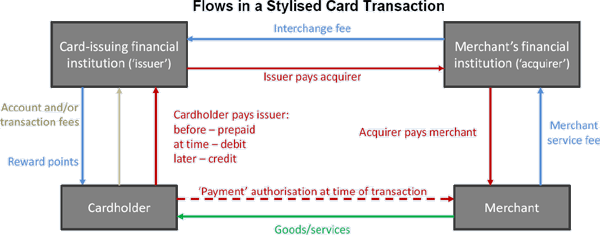Submission to the Financial System Inquiry – March 2014 Figure 8B.1

Figure 8B.1: Flows in a Stylised Card Transaction
The figure shows the flows involved in a typical card transaction. Four parties are involved – the cardholder, the cardholder's financial institution, the merchant, and the merchant's financial institution. When a cardholder authorises a payment for goods/services obtained from a merchant, this involves the cardholder paying their financial institution either: before the transaction (in the case of prepaid cards), at the time (e.g. debit cards) or later (e.g. credit cards). The transaction amount is paid by the cardholder's financial institution to the merchant's financial institution who in turn pays the merchant. Financial institutions charge fees for providing these payment services. Merchants are charged a ‘merchant service fee’ which, in part, reflects an underlying wholesale interchange fee that the merchant's financial institution must pay the cardholder's financial institution. Depending on the type of transaction, the cardholder may have to pay account and/or transaction fees to their financial institution. However, in the case of credit card transactions, cardholders commonly receive a payment from their financial institution in the form of rewards or loyalty points for carrying out the transaction. In part, these are funded by the interchange fee.